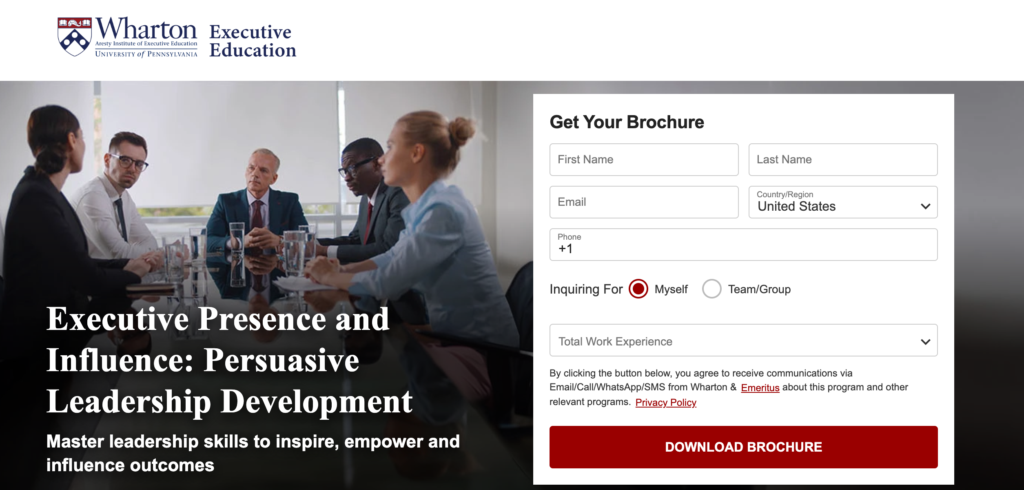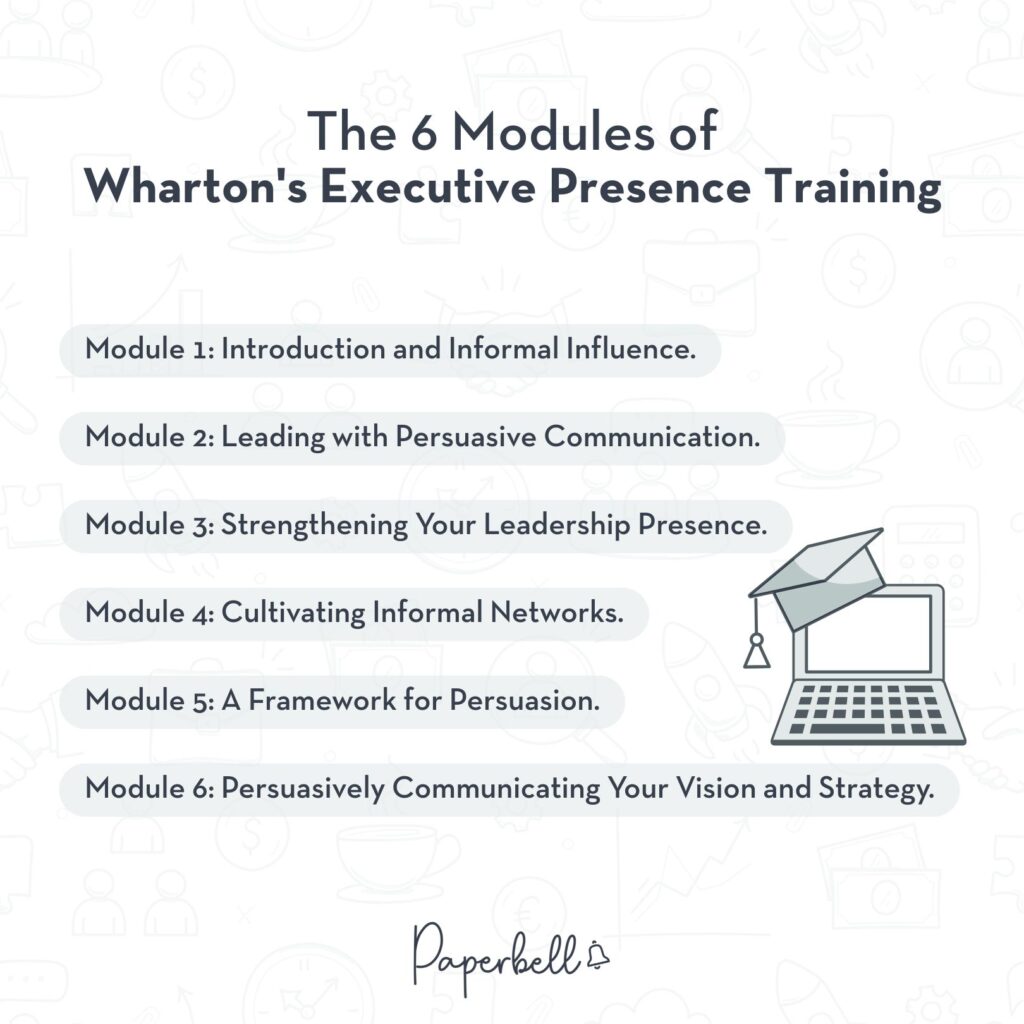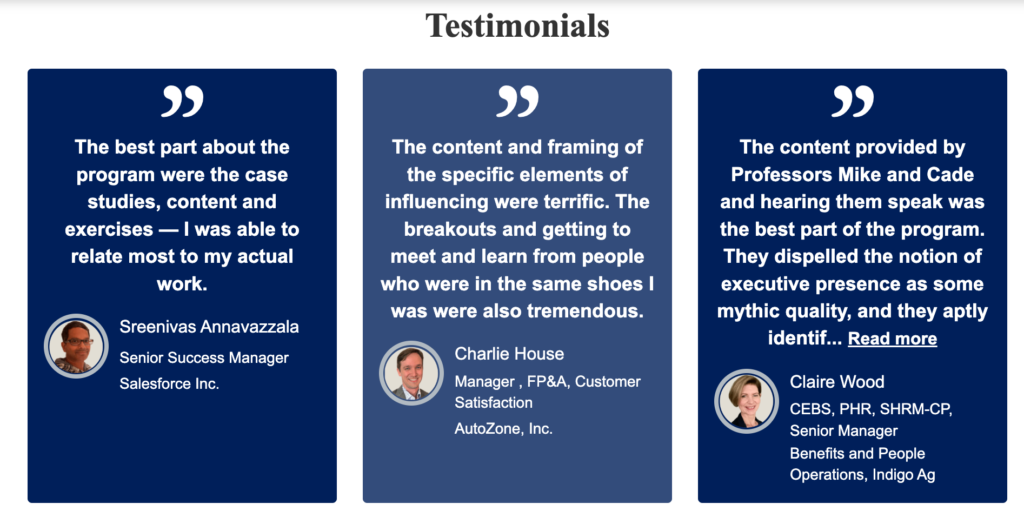Executive presence is what makes people take you seriously the moment you walk into a room. This confidence and the ability to command attention are just as important for coaches as they are for executives.
Wharton’s Executive Presence and Influence program promises to help professionals refine these skills, but is it the right investment for coaches?
In this review, we’ll cover:
- What the program includes
- It’s pros and cons for coaches
- Some alternatives for professional and personal growth as an executive coach
What Is the Wharton Executive Presence Program?

Wharton Executive Presence and Influence: Persuasive Leadership Development is a six-week online program that helps leaders refine their presence, improve their communication, and develop the persuasiveness they need to drive results for their teams. It prepares them for commanding the room, whether virtually or in person.
It’s a practical course that can be valuable for executive, leadership, management, or business coaches, as well as their clients.
Program Structure
Wharton’s program on executive influence blends theory with real-world application. Over six weeks, participants take part in:
- Live, interactive webinars
- Case studies and assignments
- Quizzes and polls to test their knowledge
- Peer discussions for practice, networking, and idea exchange
- Playbook activities to apply concepts immediately
The schedule is designed with busy professionals in mind, so you can allocate around 4-6 hours each week and complete it within the set time frame.
Cost
The program currently costs $2,730, with flexible payment plans available in two or three installments. This also includes six months of access to Emeritus Insights, a mobile app with thousands of bite-sized educational videos you can watch daily.
Who Is the Program for?
According to Wharton’s website, the training was designed for:
- Professionals preparing for senior leadership roles
- Managers who want to refine their executive presence
- Entrepreneurs looking to exert meaningful influence
- Business leaders who want to improve communication and persuasion skills
Given the focus of the curriculum, it’s also a great fit for executive and leadership coaches both as a way to improve how they show up for high-level clients and to extend their methodology.
Cohorts typically take in around 50 participants, half of them from outside the US. Learning alongside these diverse leaders is an added opportunity to build your network of like-minded professionals.
Instructors

This program is led by Michael Useem and Cade Massey, two Wharton professors with extensive experience in effective leadership and business education.
Michael Useem is a management expert and director of Wharton’s Center for Leadership and Change Management. He has authored several books on leadership development and works with organizations worldwide.
Cade Massey is a practice professor specializing in decision science. He has collaborated with top companies and professional sports franchises to develop strategic thinking and leadership skills.
Program Outcomes
By the end of the program, you’ll walk away with:
- Stronger leadership capabilities, knowing how to project confidence and authority.
- More persuasive communication skills and hands-on strategies to become an influential leader.
- A strategic approach to networking and making new connections.
- Your personal leadership narrative that aligns with your brand identity.
- A deeper understanding of influence and what drives impactful leadership.
Certification
Once you finish the program, you’ll get a digital certificate from the Wharton School. This isn’t equivalent to academic credit or a degree from the Wharton University of Pennsylvania, simply a certificate of completion.
The 6 Modules of Wharton’s Executive Presence Training

The curriculum is divided into six modules, each building on the previous one to go deeper into the practical application of leadership narrative and presence.
🎓 Module 1: Introduction and Informal Influence. Influence comes from how you position yourself in the room, not your title. This module helps you recognize informal power dynamics and leverage them to drive your agenda forward.
🎓 Module 2: Leading with Persuasive Communication. This chapter helps you learn how to communicate with confidence, clarity, and poise to make your leadership message stick.
🎓 Module 3: Strengthening Your Leadership Presence. Your leadership narrative isn’t just about the words you say but how you say them. This module explores your rhetorical strategy, leadership style, and how you can command attention without micromanaging.
🎓 Module 4: Cultivating Informal Networks. Who you know matters. Here, you’ll explore how to build and nurture a professional network that helps you and your business grow.
🎓 Module 5: A Framework for Persuasion. Persuasion is a skill that can be learned. This module breaks down the psychology of persuasion and how you can apply it in leadership and decision-making.
🎓 Module 6: Persuasively Communicating Your Vision and Strategy. Leaders and coaches need to paint a clear picture of the future. In the final module, you’ll learn how to communicate your vision in a way that inspires action and commitment.
Wharton Executive Presence and Influence Reviews
Currently, there isn’t much available about the student experience for this particular course at Wharton (some forums discuss its other courses).
There is only one detailed review from Varun Kapoor, a Program Manager at Cisco, who took the executive presence program.
He said the lectures were demanding but effective, requiring him to use new concepts in practical assignments each week. He found the capstone project of the course particularly helpful for applying executive presence in high-stakes scenarios.

Beyond this, Wharton features some curated testimonials on its website from past participants. These emphasize how effective the practical exercises and case studies were in applying what they had learned.
How Coaches Can Benefit from Wharton’s Executive Presence Training
Here’s how Wharton’s Executive Presence and Influence program can help you improve the way you express yourself as an executive coach.
1. Change the way you show up: Refine your leadership presence, so you can show up with more confidence and authority at your sessions, especially when working with high-profile clients.
2. Uplevel your communication skills: The program’s focus on persuasive communication and storytelling helps you engage clients better and make complex conversations more impactful.
3. Apply concepts immediately: Past graduates highlighted the value of practical assignments and case studies. These let you put what you learn into practice right away, and then implement them into your coaching practice.
4. Grow your network: You’ll learn with a diverse group of peers from around the world. It’s a chance to connect with leaders, even potential clients.
5. Support clients better: You can implement the practical tools you learn in this course into your coaching methodology and use them to coach leaders.
The Limitations of Wharton’s Program for Coaches
While Wharton’s Executive Presence program offers a lot of value, there are a few limitations you need to keep in mind as a coach.
1. Limited focus on coaching techniques: The program is about leadership presence and not about coaching methodologies.
2. Time commitment: The schedule requires you to invest 4-6 hours each week for six weeks—a great way to make up for the time lost is to automate your client management using Paperbell 😉
3. Focus on high-level leadership: The program is geared toward senior executives, which might not be directly relevant for coaches who work with mid-level managers, emerging leaders, or those with more casual leadership styles.
Is It Worth the Investment for Coaches?
For a program from a school like Wharton, the $2,730 price tag is fair. But if you’re looking for certification, this course won’t give you a comprehensive curriculum covering coaching techniques or core competencies. It’s more of a supplement to an executive coaching certification, so from that perspective, it’s a bit steep.
Here are some certification alternatives in this niche we’ve covered on our blog previously:
- 7 Comprehensive Business Coaching Programs for All Budgets
- The 6 Best Executive Coaching Certification Programs
That said, Wharton has great networking opportunities, and past students highlight the practical assignments as their biggest takeaway. If you want a more cost-effective option, books, online courses, and workshops cover similar ground, though they may lack hands-on practice.
Another alternative? Hiring your own coach or mentor for executive presence. It might cost you about the same but offer a more personalized experience. So it comes down to whether you prefer tailored one-on-one guidance or learning in a group of diverse leaders.
FAQ
What Are the Don’ts of Executive Presence?
Avoid over-explaining, using filler words (like, I think), or hesitating while stating your point of view. Don’t dominate conversations; listen as much as they speak. Avoid insecure body language, like slouching or avoiding eye contact.
How to Master Executive Presence?
Master executive presence by refining how you speak and carry yourself. Communicate with clarity and conviction, and project confident body language. Executive presence is developed through consistent practice, so be patient with yourself.
Is Executive Presence a Skill or a Trait?
It’s a skill. While some may naturally exude confidence, executive presence can be learned. With the right training and strategies, anyone can develop a strong, influential presence.
Does Your Coaching Practice Need a Makeover?
As an executive coach, your practice should be just as put together as yourself.
Paperbell handles your entire business from your website and bookings to your payments and contracts. It neatly organizes all your client surveys and notes, automates your email communication, and saves you hours every week on admin—that you could spend finishing your training or coaching more clients.
Try Paperbell now for free and see how it can transform your business.










